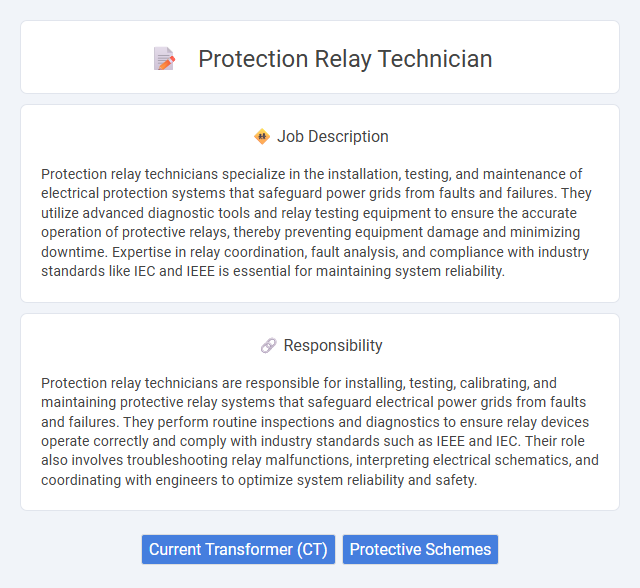
Protection relay technicians specialize in the installation, testing, and maintenance of electrical protection systems that safeguard power grids from faults and failures. They utilize advanced diagnostic tools and relay testing equipment to ensure the accurate operation of protective relays, thereby preventing equipment damage and minimizing downtime. Expertise in relay coordination, fault analysis, and compliance with industry standards like IEC and IEEE is essential for maintaining system reliability.
Individuals with strong analytical skills and attention to detail are likely to be well-suited for a Protection Relay Technician role. Those comfortable working in high-pressure environments and handling complex electrical systems probably have a higher chance of success in this job. Candidates who prefer routine physical tasks without significant problem-solving might find this position less suitable.
Qualification
A Protection Relay Technician requires specialized knowledge in electrical engineering, particularly in power system protection and relay settings. Proficiency with digital and electromechanical relays, as well as familiarity with SCADA systems and relay testing equipment, is essential. Certifications such as IEEE or NETA, combined with hands-on experience in installing, calibrating, and troubleshooting protection relays, significantly enhance job qualifications.
Responsibility
Protection relay technicians are responsible for installing, testing, calibrating, and maintaining protective relay systems that safeguard electrical power grids from faults and failures. They perform routine inspections and diagnostics to ensure relay devices operate correctly and comply with industry standards such as IEEE and IEC. Their role also involves troubleshooting relay malfunctions, interpreting electrical schematics, and coordinating with engineers to optimize system reliability and safety.
Benefit
Protection relay technicians likely experience significant career benefits due to their specialized skills in electrical system safety and reliability. The demand for experts who can install, maintain, and troubleshoot protection relays may lead to competitive salaries and job stability. Opportunities for professional growth and certifications in evolving technologies could enhance their long-term earning potential and industry relevance.
Challenge
A Protection Relay Technician likely faces the challenge of diagnosing complex electrical faults within power systems, requiring precise analytical skills and up-to-date technical knowledge. The role probably demands continuous learning to keep pace with evolving relay technologies and industry standards. Managing high-pressure situations to ensure system reliability and prevent outages could be a common and critical aspect of the job.
Career Advancement
Protection relay technicians are specialists in installing, maintaining, and troubleshooting protection systems that safeguard electrical power grids. Career advancement opportunities include roles such as protection engineer, system protection coordinator, or electrical project manager, often requiring certifications in relay technology and power systems. Gaining expertise in digital relays, SCADA integration, and advanced fault analysis significantly enhances prospects for leadership positions and higher salaries.
Key Terms
Current Transformer (CT)
A Protection Relay Technician specializes in testing, calibrating, and maintaining Current Transformers (CTs) to ensure accurate measurement and reliable operation in power systems. They analyze CT polarity, ratio, and burden to prevent relay malfunctions and system faults. Expertise in CT secondary wiring and fault detection enhances overall electrical protection coordination and grid stability.
Protective Schemes
Protection relay technicians specialize in the installation, testing, and maintenance of protective relay systems critical for electrical grid stability. They ensure protective schemes detect faults and initiate circuit breakers to minimize equipment damage and downtime. Expertise in settings coordination, relay calibration, and fault analysis is essential for optimizing relay response and maintaining power system reliability.
 kuljobs.com
kuljobs.com